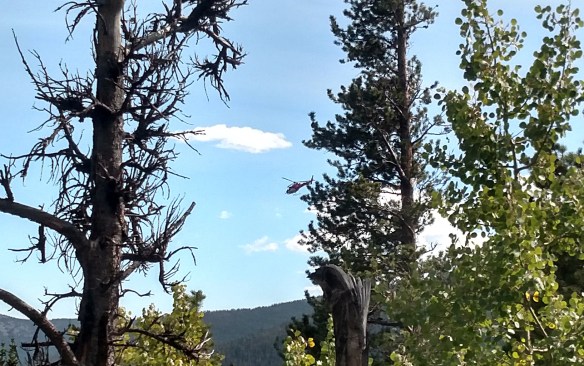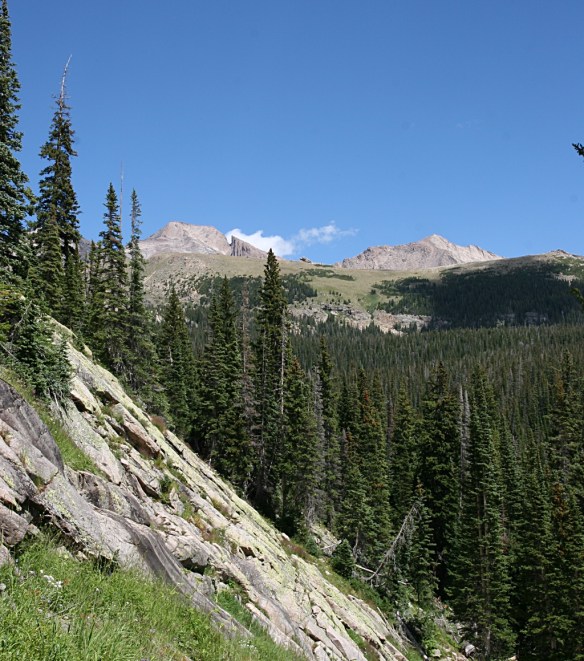Thursday, August 4
I would say I woke up around 6:00 but that wouldn’t be exactly true. The reality is that I never really got back to sleep after my attempt at astrophotography. I did get some sleep, but for the most part, I just tossed and turned. So it goes.
After breakfast, Gordon and I hit the trail a few minutes before eight. The trail only goes as far as Bluebird Lake, where we arrived in less than half an hour. Yesterday, while sitting on the shore of Bluebird for hours, I pointed out to Gordon the route I used to reach Pipit Lake several years ago and made some suggestions as to how we should attack Isolation Lake.
First, we cross the outlet. Step over three or four rocks in the stream, then climb a crack in the rock on the other side. Even though I did this round-trip when I hiked solo to Pipit, I knew I’d have a little heartburn over the descent back down the crack on the return trip. I’ve done it before, I know I can do it again, so why do I let it bother me? If this is my biggest problem for the day, I’m okay with that.
On the north shore of Bluebird is a rather large talus field. We crossed this fairly high up the slope and continued to climb on the other side, staying to the north of where Pipit hikers would go. We were essentially aiming for a spot a couple of hundred yards north of Lark Pond (which we couldn’t yet see) while trying not to get into any of the patches of willow that are in our path. We had soon reached a flatish bench and past any terrain we could see yesterday from Bluebird.
We weren’t entirely able to avoid all the willow and had to power through a few yards of the nasty stuff before coming out on the next bench. Before long, we were at the foot of a rather steep climb across another talus field. Gordon and I took different routes. I think his involved quite a bit more talus than mine. I think the talus could be avoided by swinging farther to the south and that might be an easier route, if a bit longer.
Isolation Lake sits a few feet below 12,000′, about 300′ below the saddle between Isolation Peak and Mahana Peak. The lake is not very large, a bit less than two acres. We paused here for about fifteen minutes, which I spent mostly gazing at the slope we’d need to climb to continue on to Frigid Lake. We’d climb the three hundred feet to gain the saddle and any route would involve a slope angle exceeding 35 degrees. That might not sound too bad to many people, but it’s about as steep a slope as I want to climb. Not so much for the climbing bit as for the descending bit.
Greeting the hiker upon gaining the saddle is a very dramatic view of the mountains to the north. In the near distance is Tanima Peak, just over a mile away as the crow files. Tanima is dwarfed by the mountains to the north: from left to right (west to east) are Mount Alice and Pilot Mountain, Chiefs Head Peak, Longs Peak, and Mount Meeker.
The slope down the north side of the saddle is somewhat gentler than what we just climbed. It’s a nice stroll across tundra, until the next talus field. Descending across the talus, the slope continues to steepen slowly, revealing that we’d soon need to skirt around a snow field. Grassy bits become few and far between. The final descent to Frigid Lake is down from a small ridge that skirts the south side of the lake. It’s more talus.
It was now nearly noon. We’d been hiking for four hours, mostly off trail, all of it at high elevations, and the last few yards down to the lake are talus. I capitulated. I found a nice comfy spot to take a break and have a snack. Gordon continued down to the shore of the lake. Purists might suggest that because I didn’t dip my feet in the lake, I hadn’t really visited it. I say I was close enough, purists be damned.
I dug through my backpack to find that I somehow managed to leave the GoPro in the tent, so no timelapse video from either Frigid or Isolation. Oops.
After about half an hour, I whistled to Gordon that I was heading back. Gordon is a much faster hiker than I am. No matter how much of a head start I take, he always catches up to me in short order. This time, he caught me by the time I got to the little snow field.
In my planning, I couldn’t help but note that from the top of the saddle between Isolation Peak and Mahana Peak that the summit of Mahana is only three hundred feet higher and it can be reached by making a short detour without dealing with any steep slopes. I have no doubt Gordon could have done it quickly and easily, but it’s a bit too much for me to do both Frigid Lake and summit Mahana. I’m not particularly disappointed that I didn’t even think about summiting Mahana when I was so close.
Just before reaching Isolation Lake on our return trip, we spotted a trio of bighorn sheep ewes. This is only the second time I’ve seen bighorn sheep in the park. Previously it was a large herd of ewes and yearlings and they were a couple of hundred yards away. These three were much closer. We watched them for a few minutes. At first, two of them would keep an eye on us while the third grazed. In the end, they must have figured we weren’t a threat and paid no more attention to us.
Our second break at Isolation Lake was about an hour long. The weather didn’t look too threatening, which can be a risky line of thought here below the Divide. Even with the extended break, I was still feeling the effects of climbing up and down the mountain at more than two miles above sea level. I do fine at nine or ten thousand feet, but above tree line it’s a different story.
The trip back to Bluebird was fairly straightforward. We didn’t exactly follow our route up but managed to again avoid most of the willow. Couldn’t avoid the talus, though, which was really wearing out my legs.
After a short break at Bluebird, I headed down to our camp for nourishment. And a beer. (Today’s beer was a repeat: Left Hand Brewing’s Wheels Gose Round, a delicious sour gose made with raspberry and lemon.)
Back at camp meant back in mosquito central. In that regard, the evening was a repeat of yesterday. Gordon had a bit of fun with it, though. He noticed that the corpse of one of the mosquitoes he had killed had been carted off by an ant. He dispatched fifteen or eighteen more blood-suckers and piled their remains where the ant had found the first one. Had he done this closer to my tent I might have worried I’d have to deal with a line of ants.
Having missed the opportunity to record timelapse videos at the lakes, I ran the camera to see what sort of results I might get by shooting the rugged northern flank of Copeland Mountain. As we had last night and all afternoon, there were some clouds. But they pretty much cleared up right at sunset, so I set an alarm so I could have another try getting a Milky Way shot. Unfortunately, at 11:30 I woke up to high, thin clouds and got right back into the tent.
Here’s today’s timelapse:

























































